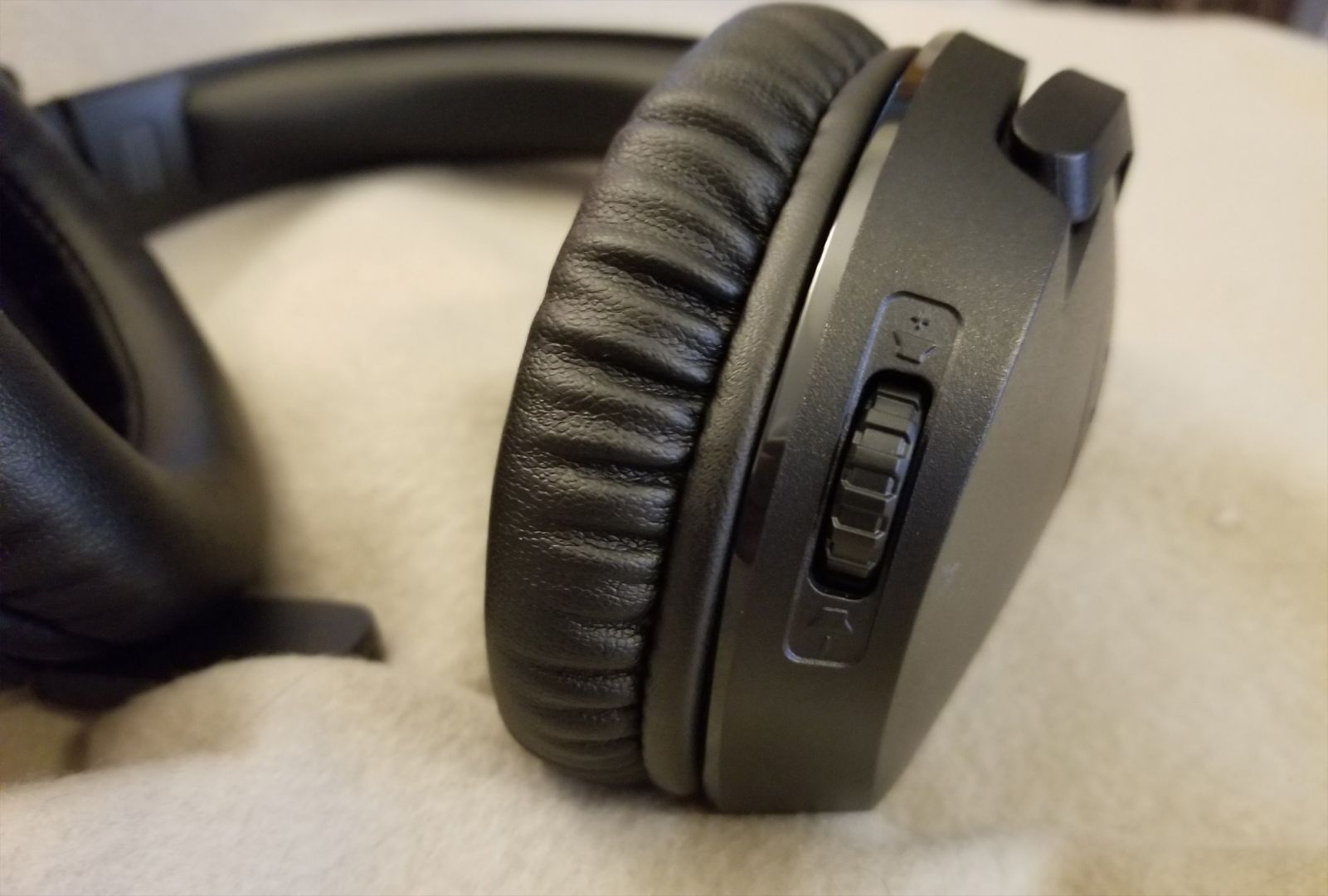

Like the Cloud Stinger before it, the Cloud Stinger Wireless attempts to bring the best audio experience possible for gamers on a tighter budget. For just shy of $100, the Cloud Stinger Wireless is certainly the least expensive wireless headset in HyperX’s arsenal, and absolutely delivers on its promise of functional, comfortable, and budget-conscientious quality.
The Cloud Stinger Wireless is fairly basic in its functionality and features, being structurally composed of a simple telescoping band with the trademark HyperX leatherette-encased memory foam along the inner top of the band and earcups. The earcups swivel 90 degrees so they can lie comfortably flat against your shoulders when you pull the headset around your neck. The right earcup features a volume wheel while the left one houses the power button, power-indicating light, micro USB charging port, and adjustable wire mic (which can swing up for storage and also mutes the microphone). The headset comes with a USB to micro USB charging cable and USB receiver.

Like every other HyperX headset I’ve reviewed, the Cloud Stinger Wireless is plug-and-play, meaning you just plug the receiver into a device with a USB port, turn on the headset, and you’re good to go. The receiver blinks with a blue light when it’s ready to receive, which becomes a static blue light when the headset is on and correctly receiving audio. As a sidenote, I was curious if these HyperX receivers were interchangeable, so I attempted to use my Cloud Flight receiver with the Cloud Stinger Wireless. Turns out they aren’t (which makes sense), but it made me appreciate one detail HyperX made. The two receivers look identical, but when plugged in, the Flight’s receiver blinks orange while the Stinger Wireless’ receiver blinks blue. This will make my life a whole lot easier if I ever accidentally toss both receivers into the same bag and need to figure out which is which.
In the past, I’ve praised HyperX’s headsets for being the most comfortable I’ve ever used and the Cloud Stinger Wireless is no exception. I can wear it for hours with no discomfort whatsoever. I had no issue with the battery life longevity and I found the sound quality to be immersive. Since I’ve previously reviewed both the original Cloud Stinger headset and the Cloud Flight (the two headsets it makes the most sense to compare against the Cloud Stinger Wireless), I thought I’d talk about the features like battery life, pricing, audio quality, and microphone quality in terms of comparisons against them.

The Cloud Stinger is wired, retails for about $50 (which is $50 less than the Cloud Stinger Wireless), and shares much of the same physical design with the Cloud Stinger Wireless. Though the exact sound of the Stinger and Stinger Wireless is not the same (since the Stinger uses analog while the Stinger Wireless uses digital), I found them to be on par with each other. The microphone quality of the Stinger Wireless was clear and unmuddled, and I give it a slight edge over the Stinger’s. That being said, in the off chance you don’t need the wireless USB option, going with the much less expensive wired Stinger will probably get you more bang for your buck.
Cloud Stinger Wireless and Cloud Flight, side by side
The Cloud Flight is wireless, retails for around $160 (which is $60 more than the Cloud Stinger Wireless), and has a different physical structure from the Cloud Stinger Wireless. I prefer the sound and the microphone of the Flight (they seem just a touch crisper), and the fit is a touch snugger around my head (which I prefer, but will certainly vary from person to person). The maximum battery life of the Flight (when its LEDs are completely off) is reported to be 30 hours compared to the Stinger Wireless’ 17 hours. As far as wireless range, while the Flight boasts a bigger maximum range (by 8 meters), while walking around my apartment, I found the ranges of the two to be about equal. There are two clear areas where the Stinger Wireless actually exceeds the Flight, however: the Flight’s microphone detaches as opposed to being on a swingable arm for storage, and the Flight’s volume wheel is much looser than the Stinger Wireless’ (which sometimes causes me issues with manually adjusting the volume properly).
After weighing all these comparisons, I think the Cloud Stinger Wireless ends up being a perfect fit for what it’s trying to accomplish. Qualitywise, it’s a slight step up from the less expensive Stinger (mostly by virtue of being wireless), but a step down in most ways to the more expensive Flight. For $100, I think the Cloud Stinger Wireless is a very good option for a somewhat lower-end wireless gaming headset. It’s being marketed more specifically for the PS4, which I think is a smart move; wired headsets for consoles are kind of a drag (since they can easily get tangled up attached to your controller), but you might not want to spring for a more expensive option. If you can pony up an extra $60 for the Flight, I might recommend it for the improved audio, microphone, and battery life, but the Stinger Wireless offers an excellent option for those who can’t or don’t wish to.
All things considered, I find the Cloud Stinger Wireless to be extremely fair in regard to its price and features. Around $100 seems to be the starting point of most wireless gaming headsets and the battery life of the Stinger Wireless appears to be better than most of the competition. Added to that, I will always trust in HyperX’s quality comfort over other headsets. The Cloud Stinger Wireless just makes sense in HyperX’s ever-growing library of headphones, each of which always seem to have their specific audience. If you belong to the target demographic of the Clound Stinger Wireless (i.e you need a wireless headset, but also need to spend $100 or less), I wholeheartedly recommend it.